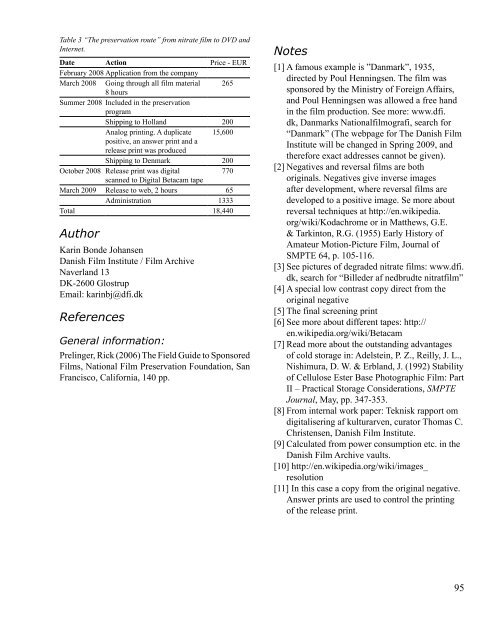dk nkf - Nordisk Konservatorforbund Danmark
dk nkf - Nordisk Konservatorforbund Danmark
dk nkf - Nordisk Konservatorforbund Danmark
Create successful ePaper yourself
Turn your PDF publications into a flip-book with our unique Google optimized e-Paper software.
Table 3 “The preservation route” from nitrate film to DVD and<br />
Internet.<br />
Date Action Price - EUR<br />
February 2008 Application from the company<br />
March 2008 Going through all film material<br />
8 hours<br />
265<br />
Summer 2008 Included in the preservation<br />
program<br />
Shipping to Holland 200<br />
Analog printing. A duplicate<br />
positive, an answer print and a<br />
release print was produced<br />
15,600<br />
Shipping to Denmark 200<br />
October 2008 Release print was digital<br />
scanned to Digital Betacam tape<br />
770<br />
March 2009 Release to web, 2 hours 65<br />
Administration 1333<br />
Total 18,440<br />
Author<br />
Karin Bonde Johansen<br />
Danish Film Institute / Film Archive<br />
Naverland 13<br />
DK-2600 Glostrup<br />
Email: karinbj@dfi.<strong>dk</strong><br />
References<br />
General information:<br />
Prelinger, Rick (2006) The Field Guide to Sponsored<br />
Films, National Film Preservation Foundation, San<br />
Francisco, California, 140 pp.<br />
Notes<br />
[1] A famous example is ”<strong>Danmark</strong>”, 1935,<br />
directed by Poul Henningsen. The film was<br />
sponsored by the Ministry of Foreign Affairs,<br />
and Poul Henningsen was allowed a free hand<br />
in the film production. See more: www.dfi.<br />
<strong>dk</strong>, <strong>Danmark</strong>s Nationalfilmografi, search for<br />
“<strong>Danmark</strong>” (The webpage for The Danish Film<br />
Institute will be changed in Spring 2009, and<br />
therefore exact addresses cannot be given).<br />
[2] Negatives and reversal films are both<br />
originals. Negatives give inverse images<br />
after development, where reversal films are<br />
developed to a positive image. Se more about<br />
reversal techniques at http://en.wikipedia.<br />
org/wiki/Kodachrome or in Matthews, G.E.<br />
& Tarkinton, R.G. (1955) Early History of<br />
Amateur Motion-Picture Film, Journal of<br />
SMPTE 64, p. 105-116.<br />
[3] See pictures of degraded nitrate films: www.dfi.<br />
<strong>dk</strong>, search for “Billeder af nedbrudte nitratfilm”<br />
[4] A special low contrast copy direct from the<br />
original negative<br />
[5] The final screening print<br />
[6] See more about different tapes: http://<br />
en.wikipedia.org/wiki/Betacam<br />
[7] Read more about the outstanding advantages<br />
of cold storage in: Adelstein, P. Z., Reilly, J. L.,<br />
Nishimura, D. W. & Erbland, J. (1992) Stability<br />
of Cellulose Ester Base Photographic Film: Part<br />
II – Practical Storage Considerations, SMPTE<br />
Journal, May, pp. 347-353.<br />
[8] From internal work paper: Teknisk rapport om<br />
digitalisering af kulturarven, curator Thomas C.<br />
Christensen, Danish Film Institute.<br />
[9] Calculated from power consumption etc. in the<br />
Danish Film Archive vaults.<br />
[10] http://en.wikipedia.org/wiki/images_<br />
resolution<br />
[11] In this case a copy from the original negative.<br />
Answer prints are used to control the printing<br />
of the release print.<br />
95

















